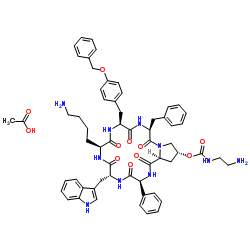396091-76-2
| Name | 662X0VFR9L |
|---|---|
| Synonyms |
PASIREOTIDE ACETATE
662X0VFR9L Cyclo[(2S)-2-phenylglycyl-D-tryptophyl-L-lysyl-O-benzyl-L-tyrosyl-L-phenylalanyl-(4R)-4-{[(2-aminoethyl)carbamoyl]oxy}-L-prolyl] acetate (1:1) Cyclo[(2S)-2-phenylglycyl-D-tryptophyl-L-lysyl-O-(phenylmethyl)-L-tyrosyl-L-phenylalanyl-(4R)-4-[[[(2-aminoethyl)amino]carbonyl]oxy]-L-prolyl], acetate (1:1) |
| Description | Pasireotide (SOM230) acetate, a long-acting cyclohexapeptide somatostatin analogue, can improve agonist activity at somatostatin receptors (subtypes sst1/2/3/4/5, pKi=8.2/9.0/9.1/<7.0/9.9, respectively). Pasireotide acetate can suppress GH, IGF-I and ACTH secretion, indicating potential efficacy in acromegaly and Cushing's disease. Pasireotide acetate also exhibits antisecretory, antiproliferative, and proapoptotic activity[1][2][3]. |
|---|---|
| Related Catalog | |
| Target |
pKi: 8.2 (sst1), 9.0 (sst2), 9.1 (sst3), <7.0 (sst4), 9.9 (sst5)[1] |
| In Vitro | Pasireotide acetate exhibits unique high-affinity binding to human somatostatin receptors (subtypes sst1/2/3/4/5, pKi=8.2/9.0/9.1/<7.0/9.9, respectively)[1]. Pasireotide acetate effectively inhibits the growth hormone releasing hormone (GHRH) induced growth hormone (GH) release in primary cultures of rat pituitary cells, with an IC50 of 0.4 nM[1]. |
| In Vivo | Pasireotide acetate (160 mg/kg/mouth; s.c. for 4 months) significantly decreases the serum insulin, increases serum glucose, reduces the tumor size and increases apoptosis in Pdx1-Cre[2]. Pasireotide acetate (2-50 μg/kg; s.c. twice daily for 42 days) exerts the antinociceptive and antiinflammatory actions via the SSTR2 receptor in a mouse model of immune-mediated arthritis[4]. Animal Model: 12 month-old conditional Men1 knockout mice with insulinoma[2] Dosage: 160 mg/kg/mouth Administration: S.c. every month for 4 months Result: Decreased the serum insulin from 1.060 μg/L to 0.3653 μg/L and increased the serum glucose from 4.246 mM to 7.122 mM. Significantly reduced the tumor size and increased apoptosis. |
| References |
| Molecular Formula | C60H70N10O11 |
|---|---|
| Molecular Weight | 1107.258 |
| Exact Mass | 1106.522583 |
